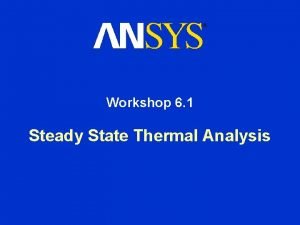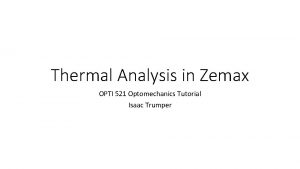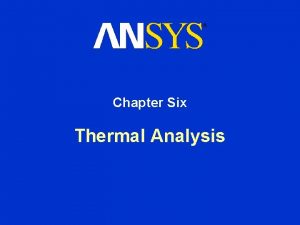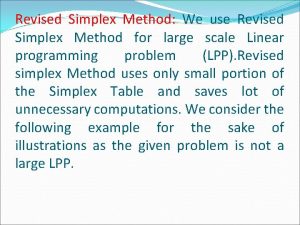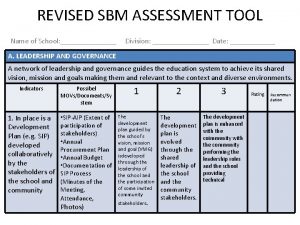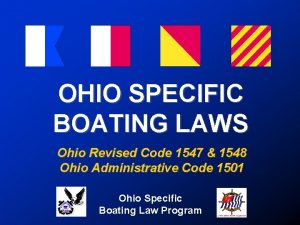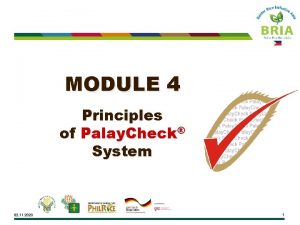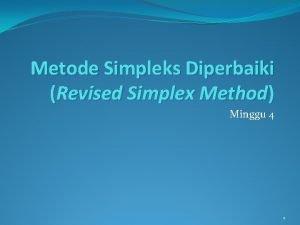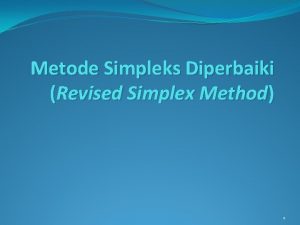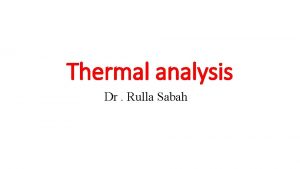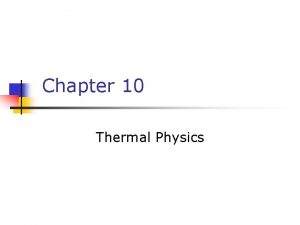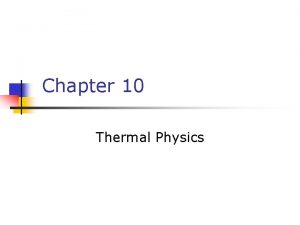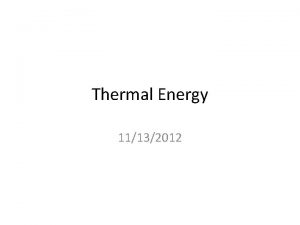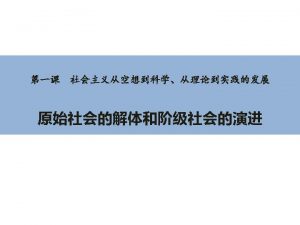ASENT Thermal Analysis Last revised 8172005 ASENTTHERMAL PPT






















- Slides: 22

ASENT Thermal Analysis Last revised: 8/17/2005 ASENT_THERMAL. PPT

Introduction The ASENT Thermal Analysis is intended to be a ‘high order’ tool, which is intended to provide rapid, approximate (plus or minus 5 degrees) answers consistent with the accuracy of the input data. This level of accuracy is sufficient to identify areas in need of further attention (either by improving the accuracy of the applied power assumptions, refining other model inputs, or relying on a thermal specialist to further analyze items suspected of having thermal issues). The ASENT Thermal Analysis tool is based on the algorithms and approach, developed and validated, by the CALCE EPRC of the University of Maryland. ASENT_THERMAL. PPT

Introduction The ASENT Thermal Analysis tool supports five different cooling methods: • Conduction with Natural Convection • Flow Over Components • Force Convection • Forced Convection with Natural Convection ASENT_THERMAL. PPT

Introduction This tutorial will show the screens and steps involved to perform a simple Thermal Analysis using a Conduction cooling method. For more details, please refer to the ASENT online help. From ASENT’s Session Manager click on the ‘Help’ menu option. Select ‘ASENT Overview’ from the drop-down menu and navigate down to the ‘Performing Thermal Analyses’ help book. Here, you will find detailed explanations and diagrams describing each cooling method, along with other helpful information. ASENT_THERMAL. PPT

Prerequisites for Performing a Thermal Analysis In order to successfully conduct a Thermal Analysis and obtain meaningful data, the Board and it’s components must have sufficient definition to provide necessary information for the calculation tool. This includes: • The board must have a ‘PWB’ component defined. • The parts should have their location on the PWB defined. Select the ‘PWB Placement’ tab to review the part placement and any unplaced parts. • The Cooling Type and Boundary Conditions must be defined. ASENT_THERMAL. PPT

PWB Defined in the Component Data Manager Here, we define the PWB component that represents our Sound card. This is done in the Component Data Manager by selecting the ‘PWBs’ tab. The ‘PWB Data’ tab is used for entering some general information about the board like its length, width, and the number of layers. Plated-Thru Hole Surface Mount ASENT_THERMAL. PPT

PWB Defined – Layer Data When defining the board we can enter detailed information about the layers that make up the card. By clicking on the ‘PWB Layer Data’ tab you can define each layer. At a minimum, be sure to approximate the amount of metal in the board. For example, 1 oz of Copper is roughly 1 mil in ASENT_THERMAL. PPT thickness (thickness is expressed in mils or 1/1000 of an inch).

PWB Defined – Composition Data Sometimes when performing a detailed thermal analysis the analyst will define regions on the board that consist of different materials. For example, a region of Copper may be defined directly below some components, to aid in drawing heat down into the board. This region of Copper may be defined on a layer that is primarily Epoxy. This information would be defined by selecting the ‘PWB Composition Data’ tab and selecting the Edit button. ASENT_THERMAL. PPT

PWB Component displayed in the Reliability Manager For our Sound card we have a PWB component as part of our part list. Here, the ‘Part Static Data’ tab is selected, and it shows us that the board has Plated. Thru Holes. It also shows the length, width and number of layers. The PWB component is added to the part list just like any other component. For more information, refer to the tutorial on Failure Rate Predictions. ASENT_THERMAL. PPT

Placement data tab selected for SOUND card Once the PWB component has been added to the part list for the Sound card, then additional data tabs will appear when we select the Sound card. Here, the ‘PWB Placement Data’ tab is selected and it shows the part placement for this card. ASENT_THERMAL. PPT

Component placement can be imported from a variety of CAD (i. e. Mentor) tools if placement data exists. However, users can easily place components on a board using ASENT’s placement tool, if that information is not available to import. Any unplaced parts will be listed on the right side of the screen. To place a part, select the part and click on the ‘Place’ button. The part will appear on the board. Click on it and drag it to the desired location. ASENT_THERMAL. PPT

Thermal setup tab selected for SOUND card This screen shows the results after we have set up the boundary conditions. To select the cooling method, boundary conditions and other parameters, click on the ‘PWB Thermal Setup’ tab and click on the ‘Edit’ button. ASENT_THERMAL. PPT

Set boundary conditions for thermal analysis Thermal Setup tool in ASENT allows the user to quickly set temperature boundary conditions in order to perform a thermal analysis. Here, the user clicks on a color from the temperature scale and then paints the edge conditions for this analysis using conduction cooling. ASENT_THERMAL. PPT

Cooling type and parameters Here, the user sets the cooling type and parameters to perform a thermal analysis using conduction cooling. There are 5 different cooling methods currently supported by the toolkit: Forced Natural Convection, Flowover Components, Forced Convection, Conduction with Natural Convection, and Conduction. ASENT_THERMAL. PPT

Run Thermal Analysis on SOUND card Now that the parts are placed on the board, and thermal setup information has been entered, merely rightclick on the board and select the ‘Calculate’ | ‘Thermal’ option. ASENT_THERMAL. PPT

PWB Analysis Display Tool By selecting the ‘PWB Analysis Results’ tab and clicking the ‘View’ button, the display tool is invoked The Display tool in ASENT allows the user to graphically display a wide variety of data. Here, the user can display either Power, Failure Rate, Case, Substrate or Junction Temperature, or the temperature values for any of the layers. A user-defined report is available for extracting just the fields that you are interested in. This is part of the normal ‘Reports’ option in the Reliability Manager. . ASENT_THERMAL. PPT

SOUND card temperatures for layer 1 Here, the user is displaying the temperature values for layer 1 on the SOUND card. ASENT_THERMAL. PPT

Thermal results for component ULL 01 The user can view the applied power, failure rate, or thermal results for a specific part by double-clicking on that part. ASENT_THERMAL. PPT

Calculated FR for ULL 01 is 7. 0033 The results of thermal analysis automatically feed the failure rate calculator. ASENT_THERMAL. PPT

Trade-offs can be performed easily Here, we change the number of thermal vias under ULL 01 from 0 to 10, and re-run the analysis. ASENT_THERMAL. PPT

Junction Temperature drops 38. 32 °C In this example, the effect of thermal vias significantly lowers the junction temperature for ULL 01 (155. 44 Degrees C versus 193. 76 Degrees C). ASENT_THERMAL. PPT

Calculated FR for ULL 01 is now 1. 6527 We calculate the failure rates using the new thermal analysis. As expected, the failure rate for ULL 01 is now much lower (1. 6527 versus 7. 033). ASENT_THERMAL. PPT
 Thermal analysis ppt
Thermal analysis ppt Section 3 using thermal energy
Section 3 using thermal energy Thermal transfer vs direct thermal printing
Thermal transfer vs direct thermal printing What is steady-state thermal analysis?
What is steady-state thermal analysis? Tga analysis
Tga analysis Zemax tutorials
Zemax tutorials Dta dsc
Dta dsc What is steady-state thermal analysis?
What is steady-state thermal analysis? Dsc
Dsc The last lesson alphonse daudet
The last lesson alphonse daudet Themes of my last duchess
Themes of my last duchess Bp form 204
Bp form 204 Betts neihart profiles of the gifted and talented
Betts neihart profiles of the gifted and talented Revised primary curriculum grade 1-3
Revised primary curriculum grade 1-3 Simplex method
Simplex method Revised 508 standards
Revised 508 standards Revised sbm assessment tool 2020
Revised sbm assessment tool 2020 Fiscal incentives for industrial promotion (revised)-2013
Fiscal incentives for industrial promotion (revised)-2013 Csrs 4400
Csrs 4400 Littering orc
Littering orc Ilang key checks meron ang palay check system
Ilang key checks meron ang palay check system Metode revised simplex
Metode revised simplex Contoh soal metode revised simplex
Contoh soal metode revised simplex



